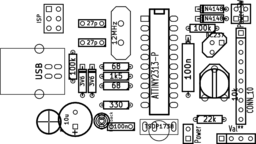usbtiny-ir-lcd-switch
Atmel has a neat microcontroller series called
AVR, which is especially suited to
use for hobby projects due to pricing, availability, ease of use and
reprogramming (all have flash), and open source toolchains (which I'm working on
for openSUSE).
For this microcontroller Dick Streefland
has created a software based USB protocol implementation called
usbtiny, including an application
to receive IR remote signals with an igorplug-usb compatible protocol.
I have stripped down the code so that I was able to add detection of a single
programmable IR signal. When the signal is detected, an output pin triggers a
power button press for 250ms. That way e.g. media center PCs can be switched on
remotely. The current state of the project is
available for
download, the git repository is probably following soon. I suggest using
gcc 4.3.3 for cross compiling (available for Debian, or from the
openSUSE project),
because the code is pretty fragile on compiler changes due to manually coded
preambles. usbtiny version 1.5 should improve that (see below).
|

|
Two python scripts are included, one for reading raw ir values and checking for
minimum/maximum intervals (train.pl) and one for programming those values
(prog_switch.py). The latter takes a raw layout, there is a script to reformat
and "soften" the values (do_prog_eeprom_ffwd.sh) - all of which isn't really
polished yet. I would rather include the reformating in prog_switch.py, but my
Python isn't really good enough for that without major pain (and I couldn't get
the Perl libusb bindings running).
My changes were based on version 1.4 of Dick's project, however, in the
meantime Dick released version 1.5. These changes have not been incorporated
yet.
Also, Dick and I currently disagree on the maximum number of cycles that
interrupts may be disabled - and it's not completely clear who is missing what
in the calculations :-) Currently I stick with my more conservative numbers. An
excerpt of the discussion can be found here,
so please comment if you think you have found a solution for us.
The current implementation just barly fits into an AVR Tiny 2313 (which has
2048 bytes flash, 128 bytes RAM, and 128 bytes EEPROM) when all features are
enabled: it uses 2044 bytes Flash, 123 bytes RAM, 70 bytes EEPROM... Pretty
dense, eh?
|

|
During this project I decided to revive my passing knowledge about board
layouting and etching. For layouting I have used
kicad, IMHO the first open source
layouting software that is actually usable, so I don't have to use proprietory
software like Eagle (which is pretty ok by itself). I'm using the classical
approach, printing to film via a
color laser printer (they have higher toner coverage than b&w printers),
exposing boards with light-sensitive resist to UV-A, and finally etching the
result with half-concentrated hydrochloric acid and little(!) concentrated
hydrogen peroxide. I won't give details here, because the resulting acid mix
may be harmful (even producing chloric gas if not handled right) and should be
left to people that have at least a little understanding how the chemicals
might react. Google for it if you think you're fluent enough in inorganic
chemistry.
The result looks pretty good, the 8/10 mil raster shows excellent sharpness and
only very little undercut. Especially considering that the material and
chemicals have been laying around here unused for - what? - 20 years...
There's only a small gap in one of the
circuit paths, looking like the base material had been damaged (the film is
100% ok in this region). Anyway, the resulting board is working just fine when
this gap is closed :-)






